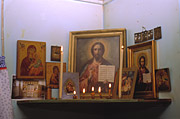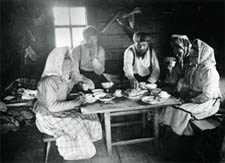| |
|
|
Skolt Sámi food tradition
There are many features in the Skolt Sámi food tradition that
link it closely with the eastern food tradition of Finland: the use of
ingredients, the ways of preparing the meal and setting the table, table
manners, tableware, the customs during family and seasonal festivals,
and the influence of the Orthodox faith.
 |
| An icon shelf in a Skolt
Sámi home. |
In their homes, the Skolt Sámi have a special place for icons
in the right-hand corner opposite to the outdoor. It is the custom to
make a sign of the cross in front of one's eyes in the direction of the
icon when entering or leaving the house and in the beginning and at the
end of a meal. In other respects, too, table manners are beautiful, and
meals are a social event in which the host and the hostess have an important
role.
The dishes that were used for preparing or eating the meal were never
used for other purposes in the household. Earlier, dishes were made from
natural materials such as wood, bone, birch bark and root.
 |
| A samovar. Photo: Sámi
Museum Siida |
Because of the contacts with Russia and the rest of the "outer"
world - through the sea - one could find a variety of dishes and objects
in the Skolt Sámi homes that had been made elsewhere from iron,
steel, silver or porcelain. Old photographs show that the Skolt Sámi
used cast-iron pots, steel samovars, steel cutlery, porcelain plates,
tea cups and pots, glasses, and glass and silver cups and goblets already
long ago.
Tidiness and hygiene were an important aspect of preparing the meal:
the ingredients were to be good and fresh, and not old or contaminated
by an animal. Meat and fish were always eaten well-done. According to
an old belief, one was not to eat fish and fowl meat at the same meal.
It was common for the Skolt Sámi to eat only the meat of animals
with cloven hooves. Drinking a lot of tea was also characteristic of the
Skolt Sámi food tradition: it was drunk many times a day.
As the yearly migration pattern of the Skolt Sámi was, at one
time, based on fishing, fish played an important role in the food tradition.
In the original home region - Petsamo - the livelihood of fishing also
included a possibility of catching salmon and other sea-fish in the sea,
and salmon in the rivers into which they came to spawn. The food tradition
included such fish dishes as kurnikkas and other fish pasties. Soups were
often thickened, and poached fish was set on a low dish and the stock
was drunk out of a cup. Salting and drying were the most important ways
of preserving fish. The seaside climate of Petsamo suited especially well
for drying fish.
For meat dishes, the Skolt Sámi used reindeer, moose, sheep and
fowl. Every part of the carcass was used. Reindeer meat was used for soups
and stews, and the blood was used for sausages and other traditional foods,
like the kumppus. In winter, the meat was preserved by freezing, and,
for summer, it was dried.
In spring, the Skolt Sámi used to collect eggs either on the coast
or from bird houses that were built for the fowl to lay eggs in. The eggs
were either boiled, fried or used as an ingredient in cakes. Cheese was
made from the milk of the sheep or the reindeer. The milk was curdled
with a piece of the reindeer's rennet bag. After that, the cheese was
gathered into a cheese mould, drained and broiled by the fire.
 |
| Pavval Sverloff with his wife and
young relatives having tea on Lake Ylä-Akkajärvi: tea, bread
and salted fish. Photo: National Board of Antiquities |
In addition to tea, berry juices and soups were drank. For tea, many
natural ingredients, leaves and little bushes were used. Especially the
tea made of unripe cloudberries or the leaves of the Labrador tea had
many medicinal properties. The Skolt Sámi often used the cambium
layer of the pine tree as an ingredient in their food. After drying, roasting
and grinding the cambium layer into flour, some of it was added into the
porridge or as a thickener into the stock of reindeer meat, fish or fowl.
Such flour was used on an everyday basis, and it was an important source
of vitamins and minerals in the simple diet of the households in the middle
of wilderness.
(Noted down by Irja Häkämies from interviews
with Marfa Orttonen, Tatjana Koputoff, Uljana Kytölä, Anni Jefremoff
and Katri Jefremoff in December 1976.)
|
|
